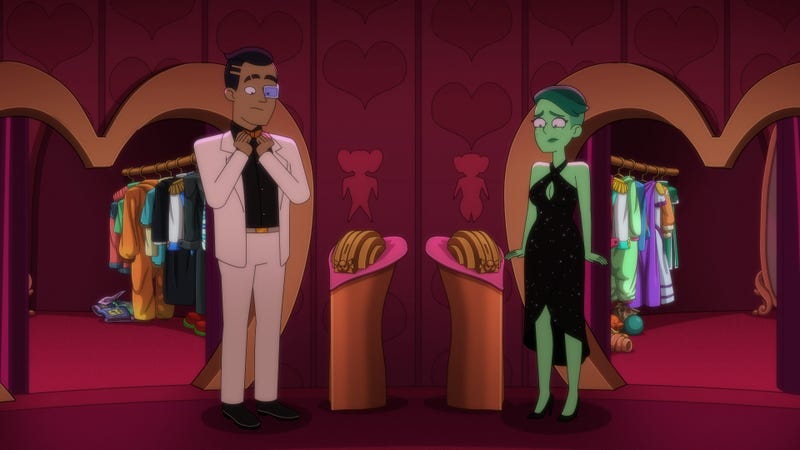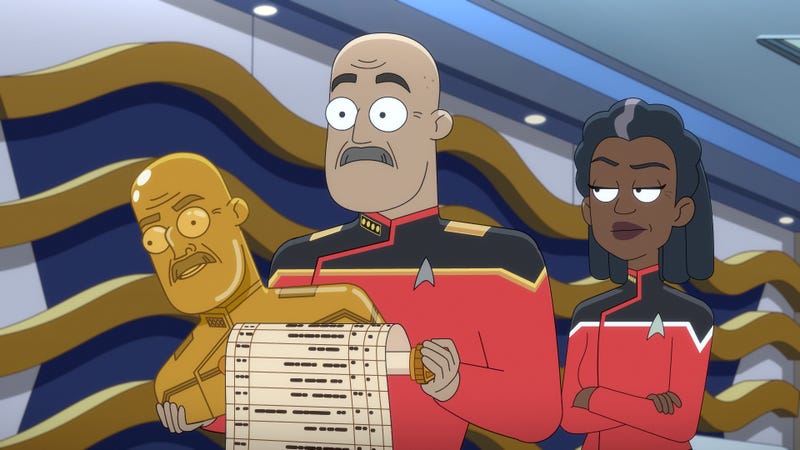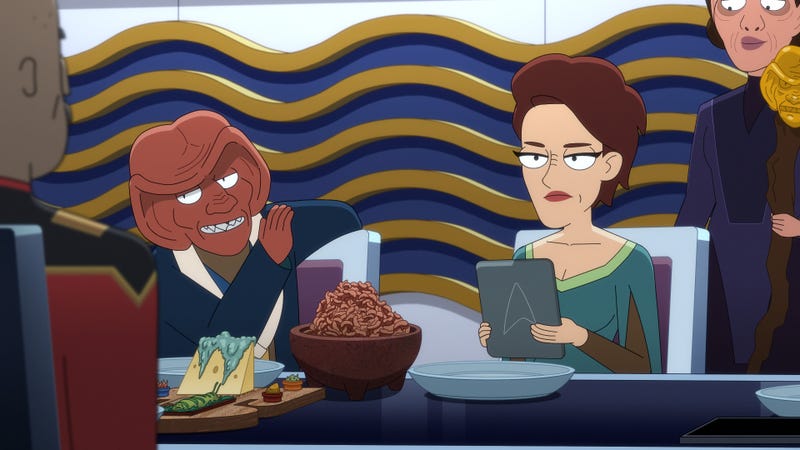In a galaxy of compelling species, the Ferengi are one of Star Trek’s most peculiar, and most fascinating. Growing from not-quite-threatening villains in their TNG debut to a fascinating capitalist foil to the Federation’s post-scarcity utopia in DS9 through characters like Quark, Rom, and Nog, their outside perspective on Star Trek makes them an incredibly compelling tool for a series to examine its heroes. But Lower Decks turned that examination on the Ferengi themselves, and to amazing effect.

The incredibly titled “Parth Ferengi’s Heart Place”—a completely out of nowhere but appreciated nod to the legendary cult comedy Garth Marenghi’s Darkplace—has to balance a fine line between advancing the personal arcs of its heroes this season with what is arguably the more interesting bulk of its subject matter: a trip to Ferenginar as Grand Nagus Rom, and his wife First Clerk Leeta (DS9’s Max Grodénchik and Chase Masterson making a triumphant return), seek to conclude negotiations with Starfleet as the Ferengi formally join the Federation.
There’s a lot to enjoy in the contrivance that sees Boimler, Mariner, Tendi, and Rutherford tag along for the ride as Captain Freeman attends meetings—a faux travel guide fact-finding trip, that larges pushes Boimler aside to give Mariner a touching advancement on her arc this season about self-sabotaging her ambitions to be an officer, and more importantly to explore Rutherford and Tendi’s will-they-won’t-they relationship in a surprisingly nuanced fashion. Aside from giving Boimler a cute gag arc (discovering that, of course, the Ferengi have mastered the art of addictive cable television), these are important and necessary steps for our heroes to take, and giving the spotlight over to the still relatively underexplored Rutherford and Tendi and twisting what could’ve been a predictable friends-to-lovers arc is just another great exploration Lower Decks has made out of defying its audience’s expectations. But it honestly explores this idea even better in what is technically the overarching B-plot of the show in giving us a proper look at the Ferengi homeworld, and how its culture has evolved in the years since DS9.

For all the iconic ‘90s series did to provide us an insight into Ferengi culture through the eyes of Quark and his family, Star Trek really hasn’t followed up in the years since on some of its most interesting evolutions of that insight, as the patriarchal, capital-fueled society—an especially aberrant element in Star Trek’s wider view of the future when it came to the alien societies it deemed allies to the Federation, if not a part of it—found itself slowly challenged from within. Although played for gags more often than not in DS9, plotlines like Quark and Rom’s mother Ishka challenging the Ferengi’s regressive view of women in its society, and Rom’s eventual ascension to leadership as the Grand Nagus on a sociopolitically progressive platform set the stage for big changes in Ferengi society, ones that now logically start to climax in what Lower Decks sets up through showing us Ferenginar’s acceptance into the Federation. And even more crucially, Lower Decks explores this advancement of the Ferengi with a delicate mix of humorous commentary and respect for Star Trek to deliver something that feels like a vital addition to the canon, broadening our view of one of the franchise’s most iconic alien species in the process.
Lower Decks never takes the easy way out that even Deep Space Nine did sometimes with the Ferengi, treating their moments of focus as a chance for farce rather than anything particularly serious. That’s not to say there isn’t humor—there’s something hilariously grim in a brief moment where we see Mariner explore a memorial to the Dominion War’s horrific loss of life that, in Ferengi style, is instead dedicated as “A Sober Farewell to Lost Profits,” for example, or even a cutting bit of commentary on our own TV industry in Boimler’s nascent addiction to Ferengi broadcasting. But “Parth Ferengi’s Heart Place” finds its greatest strength in never treating the Ferengi themselves, their attitudes and their developing culture as we explore it beyond the confines of Quark’s lens, as a joke worthy of derision. If anything, the Ferengi, and Rom’s shrewd negotiation tactics, become another important step in this season’s subverting of Star Trek fandom’s expectations, ultimately giving us something deeper than what it seems to be on the surface.

Having the Ferengi join the Federation—even though we largely knew it was coming given their prominence in Discovery’s far-flung future—is an important part of expanding our view of them, but Lower Decks cleverly still plays with their reputation as wheelers and dealers to show that, while Ferengi culture has changed and developed since we last saw it, it’s not been completely overhauled to the point of being unrecognizable. They’re still a proud people, they’re still shrewd orators and shrewder negotiators—what is diplomacy, if not another kind of business deal—and above all, they’re not stupid, as people metatextually or otherwise might often assume of them. That’s incredibly played here in Max Grodénchik’s masterful returning performance as Rom, as he and Leeta lull Captain Freeman and acting negotiator Admiral Vassery into assuming he’s a simple-minded wife guy that can be walked over into accepting Starfleet’s terms.
We likewise are lulled into the same false sense of security as an audience as Vassery is, until the twist that Leeta and Rom are actually working to strong-arm the Federation into a deal that would massively undermine them—not for insidious reasons as first assumed, but because what they actually want is for the Federation to stand up for itself under Ferengi scrutiny, to prove that they are actually taking them, and all the strides they’ve made under Rom’s leadership, seriously. Rom and Leeta want Captain Freeman to figure out what they’re really playing at, and to in turn be willing to negotiate like a Ferengi herself, out-dealing the dealers. It’s a remarkable expansion of Ferengi culture and its perspective on the Federation at large in a way that feels incredibly mindful of the years that have passed since we last really spent time with the Ferengi in Deep Space Nine, a natural evolution of the plot threads laid down by the end of that show, while still lovingly adapting what we do know about them already into new spaces and scenarios.

That Lower Decks managed to do all that while also still smartly advancing its main character’s personal arcs this season—in ways pleasantly unexpected or otherwise, considering Rutherford and Tendi’s relationship seems even stronger now in spite of the “setback” that they’re not acting on whatever potential romantic feelings they have for each other—is a package deal that even Quark would be envious of. In a season of strong episodes, perhaps no Star Trek fan would’ve expected a goofily titled Ferengi-focused story to be one of its absolute strongest so far—and in a season that has been all about defying expectation, perhaps that it is is also part of the point Lower Decks has been hammering home this time around.
Stream Star Trek: Lower Decks now on Paramount+.
Want more entertainment news? Check out when to expect the latest Marvel, Star Wars, and DC releases, what’s coming to cinemas in Australia this year, and everything streaming this month across all platforms. Check out our dedicated Entertainment tab for more.
